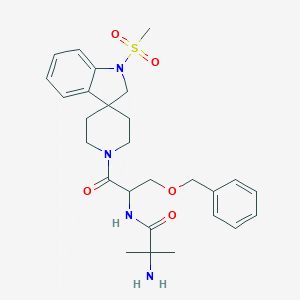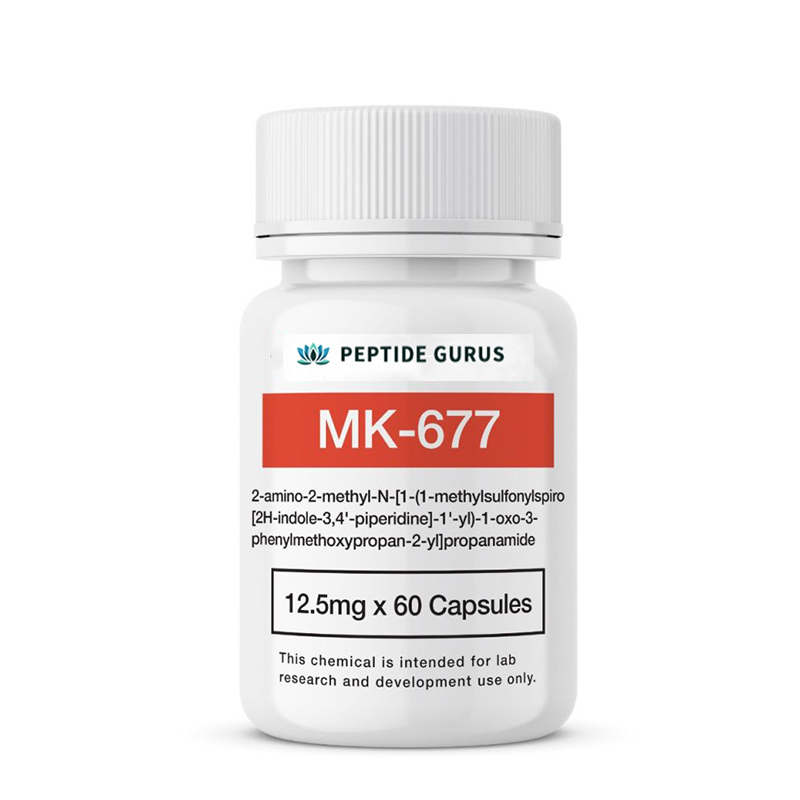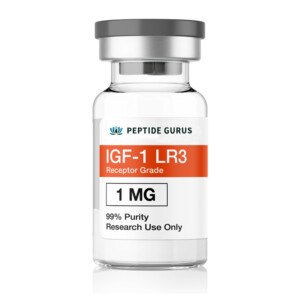MK-677, also known as Ibutamoren and Oratrope, is a orally active, selective agonist of the ghrelin receptor. Research shows that MK-677 increases the natural secretion of growth hormone (GH) y factor de crecimiento similar a la insulina 1 (IGF-1), but does not affect cortisol levels. It is being researched as a possible treatment for growth hormone deficiency, muscle and bone wasting, appetite stimulation and Alzheimer’s disease. MK-677 research in mice, appeared to prevent the onset of AD, even in genetically predisposed mice, as long as it was started before significant amyloid beta accumulation. MK-677 research has also also shown exceptionally promising benefits in improving sleep quality.
Uso del producto: Este PRODUCTO ESTÁ DISEÑADO ÚNICAMENTE COMO QUÍMICO DE INVESTIGACIÓN. Esta designación permite el uso de productos químicos de investigación estrictamente para pruebas in vitro y experimentación de laboratorio únicamente.. Toda la información del producto disponible en este sitio web es solo para fines educativos.. La introducción corporal de cualquier tipo en personas o animales está estrictamente prohibida por la ley.. Este producto sólo debe ser manipulado por personal autorizado., profesionales cualificados. Este producto no es un medicamento., alimento, o cosmético y no puede estar mal etiquetado, mal utilizado o mal etiquetado como droga, comida o cosmética.
MK-677 (Ibutamoren) Overview
MK-677, also known as Ibutamoren and Oratrope, is a potent, orally active, selective agonist of the ghrelin receptor. This makes it a growth hormone secretagogue and ghrelin mimetic. It is no a ghrelin analogue, sin embargo, as it is not a peptide and therefore shares no structural similarities to ghrelin. Research shows that MK-677 increases the secretion of growth hormone (GH) y factor de crecimiento similar a la insulina 1 (IGF-1), but does not affect cortisol levels. This means that MK-677 activates the GH axis and therefore promotes an increase in lean body mass. It is under investigation as a treatment for growth hormone deficiency, muscle and bone wasting, and appetite stimulation. MK-677 is valued for its long half-life and excellent oral bioavailability. Research in humans shows that IGF-1 levels remain elevated for up to 24 hours after a single dose of MK-677.
MK-677 and SARMs
MK-677 is often grouped with the selective androgen receptor modulators (SARMs) because it doesn’t fit neatly into any other category. MK-677 is not a SARM, sin embargo. It also isn’t a peptide. It is best described as a complex, synthetic chemical propanamide derivative that acts as a ghrelin receptor agonist[1]. Though it is not a peptide, MK-677 best fits into the growth hormone secretagogue family of peptides if considering effects. Like GHRP-2, GHRP-6, hexarelin, and ipamorelin, MK-677 binds to the ghrelin/growth hormone secretagogue receptor and boosts GH release while maintaining normal physiologic, pulsatile patterns of GH fluctuation.
One of the benefits of MK-677 is actually the fact that it is not a SARM. SARMs tend to impact natural androgen production and thus can lower testosterone levels. This means that their administration must be carefully controlled and that the compounds should be cycled on and off to avoid suppression of natural androgen production. MK-677 does not require these precautions.
MK-677 Structure
Fórmula molecular: C27h36norte4oh5S
Peso molecular: 528.7 g/mol
PubChem CID: 9939050
Número CAS: 159634-47-6
Sinónimos: MK-0677, Oratrope, Ibutamoren, L-163,191

MK-677 Research
MK-677 and Somatopause
It has been shown that without intervention, growth hormone secretion and muscle mass decline starting at mid-puberty. This ultimately leads to the frailty and loss of muscle function we see in the elderly. The progressive decline of GH and IGF-1 with age is referred to as somatopause. On average, a male at 70 years of age will produce about 60% of the growth hormone he produced at age 18. This can lead to changes in body composition, loss of bone density, y más. Curiosamente, estrogen and progesterone appear to increase GH and IGF-1 levels, thereby reducing the effects of somatopause in women as they age.
Compounds like MK-677 may offer a way of slowing or even halting the progression of somatopause. This could lead to improved muscle and bone strength in older age and may affect everything from cardiac function to brain health. Research is in its early stages, but a number of animal and human trials are showing early promise.
MK-677 and Body Composition
If somatopause is such a substantial contributor to the frailty of aging, then reversing, preventing, or slowing it could help to stave off age-related declines in bone density, muscle strength, y más. In a 2-year randomized controlled trial complete with placebo, blinding, and crossover, researchers demonstrated that once daily oral administration of MK-677 (justo 25 mg) significantly increased growth hormone levels and IGF-1 levels without serious adverse effects. This resulted in an increase in body weight of approximately 2 kg compared to placebo, increased bone mineral density, no changes in strength, and no changes in fat mass. Subjects also experienced a decrease in LDL cholesterol (bad cholesterol) and modest increases in cortisol levels. Appetite increased initially, but reverted to normal after several months[2].
One potentially interesting application of MK-677 may be in the setting of diet induced negative nitrogen balance, which is a complicated clinical way of saying low-protein consumption. Low protein consumption can be the result of a number of things, but is most often seen in the healthcare setting as a result of disease or disability. It is particularly problematic for bed-ridden patients, such as those who have suffered trauma. The ability of MK-677 to counteract negative nitrogen balance is not just about nutrition, sin embargo[3]. Protecting protein stores in the body from depletion can lead to better clinical outcomes in everything from stroke to infection. It can even help to prolong lifespan and healthspan by protecting against the disability associated with sarcopenia (muscle loss).
Previous research has shown that simultaneously boosting GH and IGF-1 can improve nitrogen retention in the setting of parenteral nutrition[3]. This is precisely what MK-677 does with a single orally administered dose. This function alone may make MK-677 a staple of intensive care units in the near future.
Research in elderly patients has shown that daily ibutamoren can boost the GH/IGF-1 axis to levels similar to those found in healthy young adults. This occurs without serious adverse effects and results in a significant increase in lean body mass, decreases in LDL cholesterol, and no change in HDL cholesterol[5]. There is some interest then in using ibutamoren as a long-term supplement to ward off the muscle loss and body composition changes associated with aging.
En general, MK-677 administration appears to have limited effects on body composition. Combined with exercise, sin embargo, it’s ability to increase GH and IGF-1 levels may help to improve muscle strength and density, reducir la masa grasa, and boost bone density. Bone density is discussed in detail in the next section.
MK-677 and Bone Density
Research in young, obese males shows that MK-677 significantly alters bone function by increasing both bone deposition and resorption[6]. Similar results are seen in elderly test subjects[7]. These findings are a classic indication of increased bone remodeling and can be either good or bad depending on the setting. Increased bone remodeling can lead to improved bone strength and resistance to fracture when paired with weight/resistance training, por ejemplo.
In a multi-center study of elderly patients with hip fracture, research shows that MK-677 can improve gait speed and reduced numbers of falls[8]. These is thus reason to believe that the compound does, En realidad, improve bone density and function, but more research is needed.
In one trial, 9 weeks of MK-677 resulted in a nearly 30% increase in serum ostocalcin and a 10% increase in bone-specific alkaline phosphatase. Both of these markers suggest increased bone deposition[5]. Individuals in these studies showed a trend toward more independent living following hip fracture. A great deal more research needs to be done, particularly as there is reason to believe that MK-677 may be synergistic with some of the growth hormone releasing hormone (GHRH) analogues and growth hormone releasing peptides (GHRP) like sermorelin and tesamorelin.
MK-677 and Neurological Function
Research in animals has demonstrated that IGF-1 is an important component in the clearance of amyloid beta from the central nervous system. Amyloid beta plaques that result from a build-up of amyloid beta are a hallmark of Alzheimer’s disease (ANUNCIO) and are indicative of disease severity. It is interesting that AD is a disease of the elderly because IGF-1 levels in the brain have been shown to decrease with age and are even lower in patients suffering from AD. The ability to raise IGF-1 levels could, therefore, provide an effective treatment or preventative for AD.
Research in elderly patients has found that MK-677 increases IGF-1 levels substantially, but does not alter the progression of AD once it has been diagnosed[9]. There is interest, sin embargo, in attempting to understand whether it can prevent AD. Desafortunadamente, such trials take extensive amounts of time and money. Research into the ability of MK-677 to prevent AD-like neurodegeneration in animal models actually contradicts the human study just discussed. This animal research is actually much newer and suggests that MK-677, more than a curative agent, is an excellent preventative. In this research, Mice that were genetically predisposed to developed AD but that were treated with MK-677 starting at three months of age showed reduced amyloid beta deposition and resulting decreases in neuron and synapse loss. En otras palabras, MK-677 appeared to prevent the onset of AD, even in genetically predisposed mice, as long as it was started before significant amyloid beta accumulation[10].

Por supuesto, the above findings are further supported by research into obesity and AD. Research in overweight mice shows that peripheral clearance of amyloid beta is impaired and that increasing IGF-1 levels helps to ameliorate this dysfunction. Desafortunadamente, this has almost no effect on levels of amyloid beta in the brain, suggesting that IGF-1 is not crossing the blood-brain barrier (BBB) very well.
MK-677 and Sleep
MK-677 has more robust effects on sleep than any of the GHRPs. Research in young adults shows that MK-677 increases stage 4 sleep duration by 50% and increase REM sleep by 20%. In older adults, the results are even more profound, with REM sleep increasing by as much as 50% and REM latency decreasing substantially[11].
Stage 4 sleep is generally considered to be the most restful stage of sleep and critical to preserving waking brain function. Stage 4 is also when most serious tissue repair and wound healing takes place. en niños, it may be associated with growth and development. Prolonging this stage of sleep could be beneficial to muscle recovery, brain function, and development.
REM sleep isn’t clearly understood, but we know that babies spend half their sleep time in REM and that this number declines with age. REM may be critical in the consolidation and reinforcement of memories, but no one really knows. The ability to prolong REM in animal models could make MK-677 a important tool for understanding the functions of sleep better than we ever have before.
MK-677 and Heart Health
It has long been known that aging leads to impairment of stem cell function. Endothelial progenitor cells (EPCs) are stem cells important in the regeneration of blood vessels. A decline in EPCs has been thought to be a risk factor for the development of atherosclerosis, which can lead to high blood pressure and heart attack among other problems. Research in mice shows that increased GH levels can help to reverse the age-related decline in EPCs and may therefore be useful in preventing heart disease[12], [13].
Further supporting the importance of GH in cardiac health is that fact the nitric oxide levels decline with age. Nitric oxide (NO) is an important regulator of blood vessel health and is critical in controlling blood pressure. GH treatment has been shown to increase NO synthase expression and thus NO levels in mice.[14] This could ultimately be an effective way to regulate blood pressure and reduce risk of a number of cardiac diseases, nefropatía, and even stroke.
MK-677 Summary
MK-677 is a non-peptide ghrelin/growth hormone secretagogue agonist that has been shown to raise GH and IGF-1 levels in both animal and human testing. The compound has gone through several human clinical trials and is generally considered to be safe and relatively free of side effects, though it has not yet been approved for human use outside of clinical trials.
Research in both animals and humans shows that MK-677 may have important benefits for appetite, body composition, muscle strength, salud cardiaca, and neurologic function. Studies have shown that MK-677 may have particular benefit in promoting vascular health and helping to stave off some of the most prevalent diseases in industrial societies (p.ej. aterosclerosis, enfermedad de alzheimer, etc.).
MK-677 also appears to have profound and beneficial effects on sleep quality. It may not only provide an effect means of improving sleep quality and probing the finer details of the sleep cycle, but it’s ability to improve sleep may help to explain some of its neurological benefits. More research needs to take place in this arena, but MK-677 shows exceptionally promising benefits in improving sleep quality.
Curiosamente, research seems to suggest that the greatest benefits of MK-667 are derived when it is taken for long periods of time as a preventative. Research may help to shed light on this particular phenomenon and set the stage for MK-677 and similar developments to act as preventatives for some of the most devastating diseases associated with age.
Autor del artículo
La literatura anterior fue investigada, editado y organizado por el Dr.. mi. logan, MARYLAND. Dr. mi. Logan tiene un doctorado de Facultad de Medicina de la Universidad Case Western Reserve y una licenciatura. en biología molecular.
Autor de revista científica
Ralf M Nass, Maryland attended medical school at University of Bochum, Alemania, and completed my residency and fellowship at University of Munich, Germany and University of Virginia (neuroendocrinology). He specialized in Endocrinology with focus on diabetes mellitus (inpatient and outpatient), thyroid disease, pituitary disease, and PCOS. In my life outside of work, I enjoy the outdoors, hiking and sports.
Ralf M Nass, MD is being referenced as one of the leading scientists involved in the research and development of VIP. De ninguna manera este médico/científico respalda o defiende la compra, venta, o uso de este producto por cualquier motivo. No hay afiliación o relación., implícito o no, entre
Citas referenciadas
- “CAS Common Chemistry.” https://commonchemistry.cas.org/detail?cas_rn=159634-47-6 (consultado en abril. 15, 2021).
- R. Nass et al., “Effects of an oral ghrelin mimetic on body composition and clinical outcomes in healthy older adults: a randomized trial," Ana. Intern. Con., volumen. 149, No. 9, páginas. 601–611, Nov. 2008, doi: 10.7326/0003-4819-149-9-200811040-00003.
- METRO. GRAMO. Murphy et al., “MK-677, an orally active growth hormone secretagogue, reverses diet-induced catabolism," J.. clin. endocrinol. Metab., volumen. 83, No. 2, páginas. 320–325, Feb. 1998, doi: 10.1210/jcem.83.2.4551.
- D. METRO. Ney, “Effects of insulin-like growth factor-I and growth hormone in models of parenteral nutrition,” JPEN J. Parenter. Enteral Nutr., volumen. 23, No. 6 Suplemento, páginas. S184-189, Dic. 1999, doi: 10.1177/014860719902300603.
- j. t. Sigalos and A. W.. Pastuszak, “The Safety and Efficacy of Growth Hormone Secretagogues,” Sex. Con. Rdo., volumen. 6, No. 1, páginas. 45–53, Ene. 2018, doi: 10.1016/j.sxmr.2017.02.004.
- j. Svensson et al., “Treatment with the oral growth hormone secretagogue MK-677 increases markers of bone formation and bone resorption in obese young males," J.. Bone Miner. res. Apagado. j. Soy. sociedad. Bone Miner. Res., volumen. 13, No. 7, páginas. 1158–1166, Jul. 1998, doi: 10.1359/jbmr.1998.13.7.1158.
- METRO. GRAMO. Murphy et al., “Oral administration of the growth hormone secretagogue MK-677 increases markers of bone turnover in healthy and functionally impaired elderly adults. The MK-677 Study Group," J.. Bone Miner. res. Apagado. j. Soy. sociedad. Bone Miner. Res., volumen. 14, No. 7, páginas. 1182–1188, Jul. 1999, doi: 10.1359/jbmr.1999.14.7.1182.
- A. Adunsky et al., “MK-0677 (ibutamoren mesylate) for the treatment of patients recovering from hip fracture: a multicenter, aleatorio, placebo-controlled phase IIb study,” Arch. gerontol. Geriatr., volumen. 53, No. 2, páginas. 183–189, Oct. 2011, doi: 10.1016/j.archger.2010.10.004.
- j. j. Sevigny et al., “Growth hormone secretagogue MK-677: no clinical effect on AD progression in a randomized trial,” Neurology, volumen. 71, No. 21, páginas. 1702–1708, Nov. 2008, doi: 10.1212/01.wnl.0000335163.88054.e7.
- Y.-O. Jeong et al., “MK-0677, a Ghrelin Agonist, Alleviates Amyloid Beta-Related Pathology in 5XFAD Mice, an Animal Model of Alzheimer’s Disease," En t. j. Mol. Ciencia., volumen. 19, No. 6, Jun. 2018, doi: 10.3390/ijms19061800.
- GRAMO. Copinschi et al., “Tratamiento oral prolongado con MK-677, un nuevo secretagogo de la hormona del crecimiento, mejora la calidad del sueño en el hombre,“Neuroendocrinología, volumen. 66, No. 4, Art. No. 4, Oct. 1997.
- t. Thum et al., “Age-dependent impairment of endothelial progenitor cells is corrected by growth-hormone-mediated increase of insulin-like growth-factor-1,” Circ. Res., volumen. 100, No. 3, páginas. 434–443, Feb. 2007, doi: 10.1161/01.RES.0000257912.78915.af.
- j. k. Devin et al., “Low-dose growth hormone administration mobilizes endothelial progenitor cells in healthy adults,” Hormona de crecimiento. Res. IGF. Apagado. j. Horma de crecimiento. res. sociedad. En t. Res. IGF. Soc., volumen. 18, No. 3, páginas. 253–263, Jun. 2008, doi: 10.1016/j.ghir.2007.11.001.
- t. Thum et al., “Growth hormone treatment improves markers of systemic nitric oxide bioavailability via insulin-like growth factor-I," J.. clin. endocrinol. Metab., volumen. 92, No. 11, páginas. 4172–4179, Nov. 2007, doi: 10.1210/jc.2007-0922.
TODOS LOS ARTÍCULOS E INFORMACIÓN DE PRODUCTOS PROPORCIONADOS EN ESTE SITIO WEB SON SÓLO PARA FINES INFORMATIVOS Y EDUCATIVOS.
Los productos ofrecidos en este sitio web se proporcionan únicamente para estudios in vitro.. Estudios in vitro (latín: en cristal) se realizan fuera del cuerpo. Estos productos no son medicamentos ni fármacos y no han sido aprobados por la FDA para prevenir, tratar o curar cualquier condición médica, dolencia o enfermedad. La introducción corporal de cualquier tipo en personas o animales está estrictamente prohibida por la ley..








